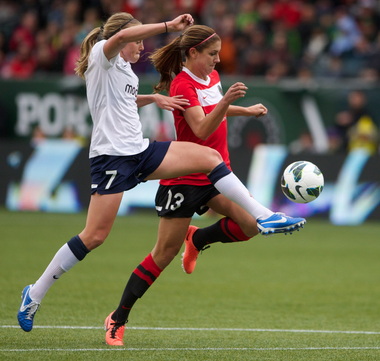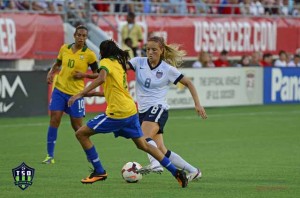
Alex Morgan fights off a defender in a 2013 contest against the Washington Spirit. Her team, the Portland Thorns, operates under the same organization as the Portland Timbers of the MLS, the men’s equivalent of the female team. (Oregon Live)
by: Tyler Chiu
10/04/2015
The National Women’s Soccer League is the highest level of women’s professional soccer in the United States, organized by the US Soccer Federation and its subsequent Major League Soccer sponsors. The league is the present product of two defunct women’s leagues, with the first league suffering harrowing losses of over $100 million USD before finally folding. Fortunately, the current NWSL has found sufficient success in its past three years of operation, primarily due to its adoption of the European model of partnering with a men’s professional league. Nevertheless, the NWSL inexorably runs with risk of travelling the same path of its past two successors notwithstanding the success of the 2015 FIFA Women’s World Cup. This supposition is unequivocally true because of the NWSL’s inability to adopt one or more of Porter’s Generic Strategies and differentiate itself from the plethora of professional sports leagues in the United States.

Abby Wambach, the face of women’s soccer, celebrates her team’s World Cup victory in Vancouver this past summer. Despite the tournament’s gargantuan success, the domestic NWSL league has continued failed to acquire an additional sponsor. (The Guardian)
At face value, the NWSL seems to attempt incorporate a cost leadership strategy with its operationally efficient distribution of salaries, remunerating its players with a stipend of approximately minimum wage ($6000-$30,000.) However, the league’s teams are required to remunerate a multitude of staff, personnel and administration, which efficaciously eats up most of the match day revenue that the teams produce. With extraordinarily low salaries, the NWSL also runs the risk of losing its top-tier players (human capital) to its European counterparts and losing its players in general to more lucrative 9-5 office employment. On the differentiation front, the NWSL has failed to cater to neither a younger niche market (Narrow Market Segment) nor the growing industry as a whole (Broad) because of its inability to differentiate the on and off-field product from the immensely successful NCAA women’s soccer and the MLS men equivalent, thereby making the notion of charging its spectators a greater premium preposterous.

Young US superstar Kristie Mewis sizes up her opponent in an international match against Brazil. She, among a multitude of others, has chosen to pursue her career overseas at Bayern Munich in Germany. (The Soccer Desk)
Even with globally recognized assets such as Alex Morgan and Carli Lloyd available at the league’s disposal, the league has failed to translate the exciting on-field product into a revenue generating stream. In the past, a lack of resources and sponsorships made the folding of the previous two women’s leagues excusable. The NWSL must develop a Porter strategy in order to survive the capricious nature of professional sports. Otherwise, it will eventually dig its own grave alongside its two infamous predecessors.
Cool stuff. Nice to see your writing is still brilliant!